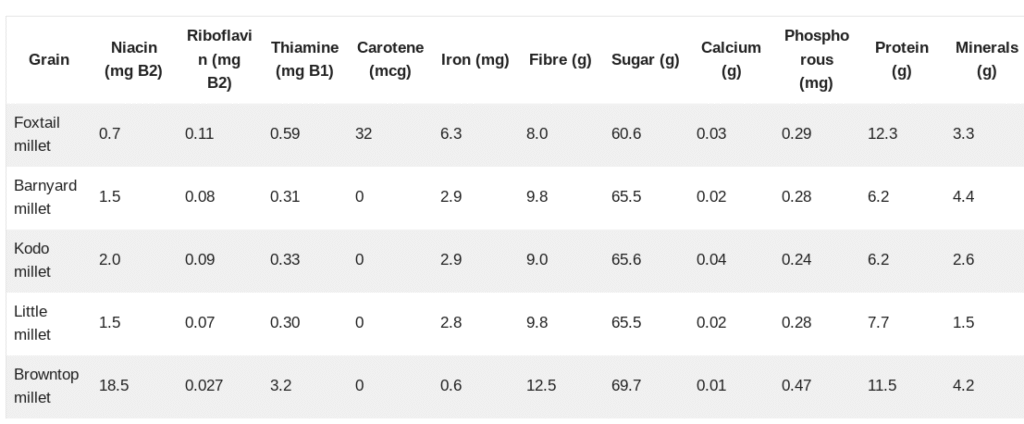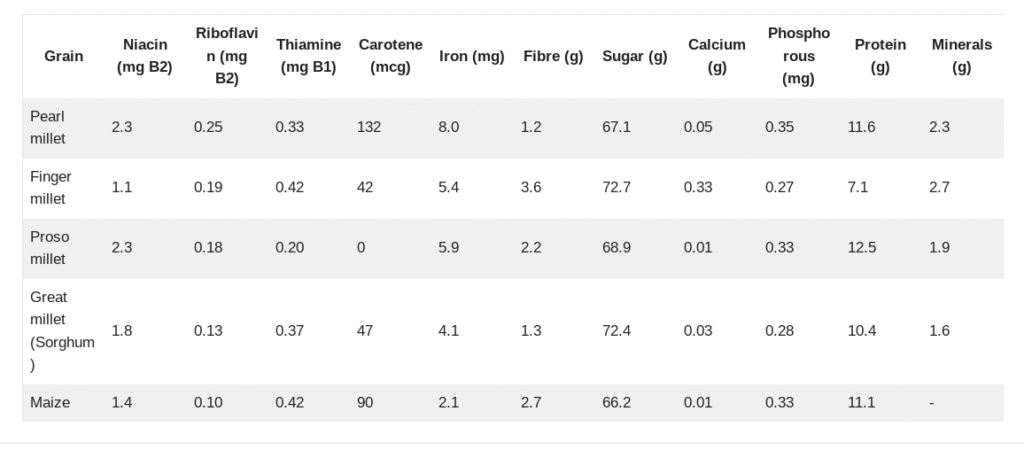This foundational guide on Browntop Millet offers more than just facts — it carries the wisdom and research of the renowned “Millet Man of India”, whose dedication has brought ancient grains back into the spotlight. Before diving into the incredible health benefits of Browntop Millet, take a moment to explore our blog post: What is Millet?
Table of Contents
Why the Name Browntop?
Browntop millet gets its name primarily from the appearance of the plant and its grain:
- “Brown” refers to the color of the mature seeds or grains, which typically have a brownish hue.
- “Top” refers to the seed head or panicle of the plant, where the seeds grow — essentially, the “top” part of the plant.
So, “Browntop millet” literally describes a millet variety with brown-colored seed heads or grains at the top of the plant.
Browntop millet was an important staple food in ancient Indian civilizations, valued not only for its nutritional benefits but also for its ability to thrive in harsh climates. It was widely cultivated in the arid and semi-arid regions of Southern India, including states like Andhra Pradesh, Karnataka, and Tamil Nadu. It also spread to other parts of India, such as Gujarat and Tamil Nadu.
In addition to being a food crop, Browntop millet has also been used as a fodder crop for livestock by regions like in the USA. While historically a staple crop, its cultivation declined with the rise of high-yield varieties like rice and wheat during the Green Revolution. It grows in the shortest period of time, it can be harvested in 75 days and the least amount of water is required to grow this wonderful grain.
Let’s take a look at how the Browntop millet is called in Hindi, Telugu, Tamil, Kannada, Gujrati & Punjabi languages –

Health Benefits
Browntop millet is a positive grain & a superfood. As shared by the revered “Millet Man of India,” this title isn’t just a label, but a reflection of its powerful impact on our well-being. With a rich fiber content of 10% and a carbs-to-fiber ratio of less than 10, Browntop millet stands out as a truly nourishing whole grain. It has the natural ability to cleanse, heal, and rejuvenate the body, offering real hope in reversing lifestyle-related diseases. Browntop millet may be small in size, but it’s a powerhouse of nutrition. This ancient grain, once a staple in traditional diets, is now gaining attention as a modern superfood. Here’s why adding Browntop millet to your meals can be a game-changer for your health:
🧍1. Healthy Digestive Canal
Browntop millet cleans the digestive canal, from mouth to rectum. All who have any digestive issues say heart burn, gastric problem, piles, constipation, fisher etc, eating browntop millet ambali (fermented porridge) will help, according to Dr. Khader Vali (see details in Video section).
🧠2. For Brain, Lungs, Joints, Skin
Browntop millet is a superfood, beneficial in joint pain, lung related issues, nerve related issue, brain related issue, loss of memory etc.
🌾3. Rich in Fiber – Supports Digestion and Weight Loss
Browntop millet contains nearly six times more fiber than white rice, making it excellent for digestion. It helps regulate bowel movements, prevents constipation, and keeps you feeling full longer—supporting healthy weight management.
🩸 4. Low Glycemic Index – Great for Diabetics
This millet has a low glycemic index (GI), which means it releases sugar slowly into the bloodstream. This prevents sudden spikes in blood sugar levels, making it an ideal grain for diabetics and those managing insulin resistance. To read in detail how millet can help reverse diabetes check the blog post here.
💪 5. Gluten-Free – Safe for Celiac and Gluten Sensitivity
Being naturally gluten-free, Browntop millet is a safe and healthy choice for people with celiac disease or gluten intolerance. It’s a wholesome alternative to wheat-based products.
🦴 6. Good Source of Calcium and Phosphorus – Supports Bone Health
This millet provides calcium and phosphorus, which are essential for strong bones and teeth. It’s particularly beneficial for growing children, pregnant women, and older adults at risk of osteoporosis.
🏋 7. High in Antioxidants – Boosts Immunity
Browntop millet is loaded with phenolic compounds and antioxidants that help fight oxidative stress in the body, supporting the immune system and reducing the risk of chronic diseases.
🏃 8. Quick Energy – Ideal for Active Lifestyles
Because it digests slowly but steadily, Browntop millet provides long-lasting energy. It’s a perfect grain for athletes, children, and anyone needing sustained stamina throughout the day.
💗 9. Heart Health
Its fiber and low carbohydrate content can contribute to lower LDL cholesterol and improve heart health.
🏋 10. Superfood – Rich in Nutrients
Browntop millet is rich in fiber, proteins and B vitamins essential for the human body. It is a powerhouse of nutrition. For nutritional value check Nutrition.
Nutrition
Here you find Nutrients and Fiber content in 100gm of Browntop Millet in comparison with rice & wheat and other millet.
Comparison with Rice & Wheat
Here’s a more comprehensive chart comparing browntop millet, paddy rice, and wheat along with other millet based on average values per 100 grams: Source: Dr. Khader Vali
Positive Grains (Siridhanya)

Neutral Grains

Negative Grains

Watch video in Hindi for detailed explanation.
Key Takeaways:
- Browntop millet has highest fiber content and B vitamins – Niacin & Thiamine, also minerals like phosphorus and good protein levels.
- It has a lower glycemic index, making it a better option for blood sugar management.
- Refined wheat flour & rice, is nutritionally depleted during processing and lacks the mineral diversity and fiber content of millet. Whole wheat has better nutrition than rice but it has gluten, causing gluten related health issues.
Health Benefits Comparison with Rice & Wheat
| Health Aspect | Browntop Millet | White Rice | Whole Wheat |
|---|---|---|---|
| Gluten-free | ✅ Yes | ✅ Yes | ❌ No |
| Supports digestion | ✅ High fiber | ❌ Very low fiber | ✅ High in fiber |
| Blood sugar control | ✅ Low GI, slow carb absorption | ❌ High GI; quick sugar spikes | ⚠️ Moderate GI |
| Weight management | ✅ Keeps you full longer | ❌ Less filling | ✅ Good satiety |
| Heart health | ✅ Rich in antioxidants & magnesium | ❌ Poor in heart-protective nutrients | ✅ Supports heart health |
| Bone strength | ✅ Good calcium & magnesium | ❌ Low in bone-support nutrients | ✅ Moderate calcium & magnesium |
| Rich in B Vitamins | ✅ Supports energy, nerves, and brain health | ❌ Very low in B vitamins | ✅ Especially rich in niacin & thiamine |
| Antioxidant content | ✅ High | ❌ Very low | ⚠️ Moderate |
| Iron content | ✅ High | ❌ Low | ✅ Good amount |
🧠 Why B Vitamins Matter
- Thiamine (B1): Supports nerve function, energy metabolism, and muscle health.
- Riboflavin (B2): Important for skin, eyes, and converting food into energy.
- Niacin (B3): Helps lower cholesterol, supports brain health, and aids in DNA repair.
In Summary:
Browntop millet is more than a traditional grain—it’s a nutritional gem that supports soft organs like liver, pancreas, gall bladder, kidney, spleen, heart health, boosts energy, controls blood sugar, and strengthens bones, all while being gentle on the gut.
A bowl of browntop millet is not just food—it’s nourishment, healing, and heritage in every bite.
Cooking Fermented Porridge (Ambali)
According to the Millet Man of India, eating fermented porridge (Ambali) of millet is most beneficial as it helps reverse lifestyle diseases.
Here is a simple guide on how to cook Browntop millet into fermented porridge (also known as Ambali) for maximum health benefits:
✅ Ingredients:
1 cup Browntop millet
6 cups or more water (adjust depending on millet type and texture preference)
Optional: A pinch of salt or spices
🥣 4 Easy Steps:
1. Rinse and Soak
Rinse the millet 2–3 times to remove dirt and excess starch.
Soak in water for 8-10 hours or overnight. This millet has highest fiber hence soak it 2 hrs more than other millet.
Soaking millet in water before cooking is essential for several health and cooking benefits. Here’s why:
Improves Nutrient Absorption
- Millets contain phytates (anti-nutrients) that bind to minerals like iron, zinc, and calcium, making them harder to absorb.
- Soaking helps reduce phytate levels, improving bioavailability of nutrients.
Aids Digestion
- Soaking helps break down complex starches and proteins, making millet easier to digest.
- It can also reduce bloating and gas, especially for people with sensitive stomachs.
Reduces Cooking Time
- Pre-soaked millet cooks faster and more evenly.
- This saves fuel or energy and ensures a better texture.
Lowers Glycemic Impact
- Soaking can slightly reduce the glycemic index by activating enzymes that pre-digest some of the starches, helping in better blood sugar control.
Enhances Flavor and Texture
- Soaked millet often has a softer texture and milder flavor, making it more palatable and versatile in recipes.
2. Cook Millet in Boiling Water
- Take an earthen clay cookware or steel pan
- Put 6 times water and boil the water
- Put soaked millet along with water used for soaking it
- Let it cook in medium flame/heat till half the water evaporates
- Slow the flame/heat & cover with lid till only little water is left
- Stop the gas/heat & leave it covered with lid for 30 mins till it slightly cools down
3. Ferment
- Cover the earthen ware with cloth, tighten the cloth
- Leave it still in one corner for 4-6 hrs (if its summer season) or 8-12 hrs (if its winter)
- Let it ferment
- Time required for fermentation is same as that of the curd
4. Add Salt/Spices/Vegetables
- After the fermentation is complete, you can add pinch of salt or spices(tadka) or sauted vegetables to make it tasty
🍽️ Tips:
- You can grind the millet before soaking if you want it more watery, this step is optional
- Do not heat it again after fermentation
- Do not add salt before fermentation, it can be added only after fermentation
- Curd or anything if desired to be added, should be added only post fermentation
If you have any doubts, watch the video on how to make millet fermented porridge here.
For more healthy Browntop Millet recipes check here.
Who is the Millet Man of India?
The “Millet Man of India” is Dr. Khader Vali, a food and nutrition scientist renowned for promoting the cultivation and consumption of millets across India, especially traditional varieties like foxtail, little, kodo, barnyard, browntop, and proso millets.
Key Contributions of Dr. Khader Vali:
- Advocates millets as a solution to lifestyle diseases like diabetes, obesity, hypertension, and even certain cancers.
- Promoted the concept of “Siri Dhanya” (positive millets) to differentiate more nutritious millet varieties.
- Encouraged organic farming and natural healing through diet.
- Honored with the Padma Shri award in 2023 for his contribution to health and sustainable agriculture.
Videos
Watch this video in English to hear about Browntop millet by Dr.Khader Vali
Watch the video in hindi below.
Conclusion: A Whispered Cure for Modern Need
In fields where golden sunlight weaves,
Browntop millet gently breathes.
A humble grain, so small, so wise,
With roots that kiss the thirsty skies.It asks for little, gives us more,
From ancient soil to health’s rich store.
A healer cloaked in earthy grace,
It brings lost time a warm embrace.With fiber fine and iron deep,
It wakes the strength that once did sleep.
For hearts grown tired, for minds that roam,
This grain becomes both food and home.So let us turn to nature’s song,
To grains that kept our grandmothers strong.
Browntop, the quiet, noble seed—
A whispered cure for modern need.

4 thoughts on “Browntop Millet: 10 Health Benefits & Ambali Recipe for Healing”